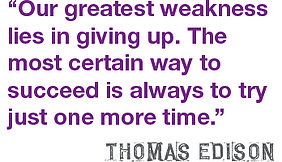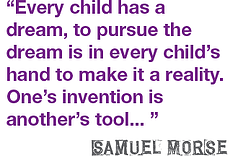
Your student could be the next Thomas Edison!
No one will argue that children have a limited imagination. We all know that with the most basic of objects, children can create things to entertain themselves (and their parents) for hours.
Case in point: On a family vacation a few weeks ago, I watched my nieces and nephews construct a fort (it was really more like a small city) out of every item in the house. It took up the entire living room and was comprised of chairs, couches, sheets, and other miscellaneous items.
 In its simplest form, this is how every “maker” gets his or her start. Seemingly random items become something “made,” which can provide hours of entertainment or years of practical use. As children grow older, they sometimes lose that creative urge. But today, there seems to be an increasing number of makers among our youth – enough to comprise a “movement.”What is this Maker Movement all about?
In its simplest form, this is how every “maker” gets his or her start. Seemingly random items become something “made,” which can provide hours of entertainment or years of practical use. As children grow older, they sometimes lose that creative urge. But today, there seems to be an increasing number of makers among our youth – enough to comprise a “movement.”What is this Maker Movement all about?
The Maker Movement can mean different things to different people, but essentially it refers to embracing the ability to create useful things from scratch. In the past, “making” technology or advanced products required knowledge and access – things only available to professionals. Today, however, the possibilities are endless. We have everything from your basic needle and thread to more advanced maker tools, like the Raspberry Pi, Arduino, and 3D printers. The Maker Movement is catching fire with students, and I believe we will see an explosion of products created and problems solved in the coming years.
Here are two other descriptions of the Maker Movement:
- From techopedia: “The maker movement is a trend in which individuals or groups of individuals create and market products that are recreated and assembled using unused, discarded or broken electronic, plastic, silicon or virtually any raw material and/or product from a computer-related device. The maker movement has led to the creation of a number of technology products and solutions by typical individuals working without supportive infrastructure. This is facilitated by the increasing amount of information available to individuals and the decreasing cost of electronic components.”
- From the Maker Manifesto: “Making is fundamental to what it means to be human. We must make, create, and express ourselves to feel whole. There is something unique about making physical things. Things we make are like little pieces of us and seem to embody portions of our soul.”
Why is the Maker Movement so important to Academic Mindsets?
The academic mindsets, four key beliefs that influence learning behaviors and enable learning success, affect student motivation, strategies, and perseverance. The Maker Movement touches on each and every one of these academic mindsets. (For more information about the academic mindsets, read my previous post, here.)
 The Growth Mindset: By crafting things – whether it’s a simple necklace or something more complicated, like retrofitting your gloves to work with an iPhone – students can clearly see that they build specific skills with each completed project. They may start off making something based on a plan found on the Internet, but once they master some basic skills, their creativity will grow. Eventually you may find them creating amazing solutions to difficult problems.
The Growth Mindset: By crafting things – whether it’s a simple necklace or something more complicated, like retrofitting your gloves to work with an iPhone – students can clearly see that they build specific skills with each completed project. They may start off making something based on a plan found on the Internet, but once they master some basic skills, their creativity will grow. Eventually you may find them creating amazing solutions to difficult problems.
 The Self-Efficacy Mindset: By assigning smaller, more achievable projects to students, you can build their confidence in specific skills. Students will quickly see that the project can be completed, and will begin to believe in their ability to build something useful. Once they master a skill, you may find them switching to a Growth Mindset and pushing the limits of that skill.
The Self-Efficacy Mindset: By assigning smaller, more achievable projects to students, you can build their confidence in specific skills. Students will quickly see that the project can be completed, and will begin to believe in their ability to build something useful. Once they master a skill, you may find them switching to a Growth Mindset and pushing the limits of that skill.
 The Sense of Belonging Mindset: Working with groups of other students helps students feel engaged and accepted by their peers. “Making” instills a sense of purpose and motivation to learn the finer details of the STEAM fields (Science, Technology, Engineering, Art + Design, and Math).
The Sense of Belonging Mindset: Working with groups of other students helps students feel engaged and accepted by their peers. “Making” instills a sense of purpose and motivation to learn the finer details of the STEAM fields (Science, Technology, Engineering, Art + Design, and Math).
 The Relevance Mindset: This mindset is the easiest to talk about when engaging students using the “maker” mentality. Students can quickly and clearly see how a skill can be directly applied to creating a tangible item. But learning how educational concepts relate to real world projects and problems is essential to student engagement and deeper learning. Without understanding the “why,” students are less likely to embrace learning.
The Relevance Mindset: This mindset is the easiest to talk about when engaging students using the “maker” mentality. Students can quickly and clearly see how a skill can be directly applied to creating a tangible item. But learning how educational concepts relate to real world projects and problems is essential to student engagement and deeper learning. Without understanding the “why,” students are less likely to embrace learning.
Some activities to help foster the “Maker” in your student
Following are some suggestions for getting your students into the maker mode, plus links to helpful resources:
- Find a relevant project on Instructables.com or get an idea from Etsy.com. Have students create it in the classroom, or assign it to them as a homework project. Make sure the project is relevant to the subject matter you are teaching, so that students can see the importance of learning.
- Take a field trip to a local Maker Faire or local Maker Meetup to help students get ideas for projects they can create. Have the students document the steps they take in finishing their projects, so they have pictures to share with the world.
- Have students use a camera such as the MimioView™ document camera to capture images of their work for digital portfolios, which they can then present to the class as a video.
- Some real-life examples of 3D printers were used across STEM and design projects.
- Here’s a great article describing other maker activities for the classroom.
Please share your most successful approaches and activities with other educators on mimioconnect.com. With a free membership to the MimioConnect® online community, teachers can connect with each other to share lessons, best practices, and ideas.
Download these and other Student Maker Activites here.>>
Some notable “Makers”
Kia Silverbrook
Australian inventor, scientist, and serial entrepreneur, who has been granted 9,874 patents worldwide. Silverbrook has founded companies and developed products in a wide range of disciplines, including computer graphics, video and audio production, scientific computing, factory automation, digital printing, liquid crystal displays (LCDs), molecular electronics, Internet software, content management, genetic analysis, MEMS devices, security inks, photovoltaic solar cells, and interactive paper.
Shunpei Yamazaki
Japanese inventor in the field of computer science and solid-state physics, with over 3,193 patents. Many of his inventions have shaped the modern world as we know it. Without his inventions, some of the technology we use every day (mobile phones, computers, etc.) would not be possible.
Thomas Edison
American inventor and businessman who holds 1,093 patents. Widely known as the world's most prolific inventor, he developed devices that changed the lives of people worldwide, such as the lightbulb (his key improvements made it practical to use lightbulbs in everyday life), the phonograph, and the motion picture camera.
Some notable student “Makers”
Philo Farnsworth
Inventor of the electronic television, for which he conceived the basic idea at the age of 15. He produced a working prototype six years later.
Louis Braille
At the young age of 12 he invented Braille writing to help the blind read with their fingers. He worked tirelessly on the invention for over 16 years, and eventually the system allowed the blind to read letters with the touch of a single finger.
George P. Nissen
Using materials he found in a junkyard, 16-year-old gymnast and diver George Nissen created the first trampoline in 1930 by stretching canvas over a steel frame. A few years later, working with college gymnastics coach Larry Griswold, he perfected his invention by using nylon.
The real importance of nurturing and embracing the Maker Movement
 Each year, one million students leave school without earning a high school diploma. There are many reasons why students drop out, but one key reason is the lack of one or more of the academic mindsets. By embracing the Maker Movement and educating students on the educational mindsets, we can help them realize the practical aspects of education and help them succeed through high school and beyond. Who knows? A student of yours might one day invent the next light bulb and change the world forever!
Each year, one million students leave school without earning a high school diploma. There are many reasons why students drop out, but one key reason is the lack of one or more of the academic mindsets. By embracing the Maker Movement and educating students on the educational mindsets, we can help them realize the practical aspects of education and help them succeed through high school and beyond. Who knows? A student of yours might one day invent the next light bulb and change the world forever!


